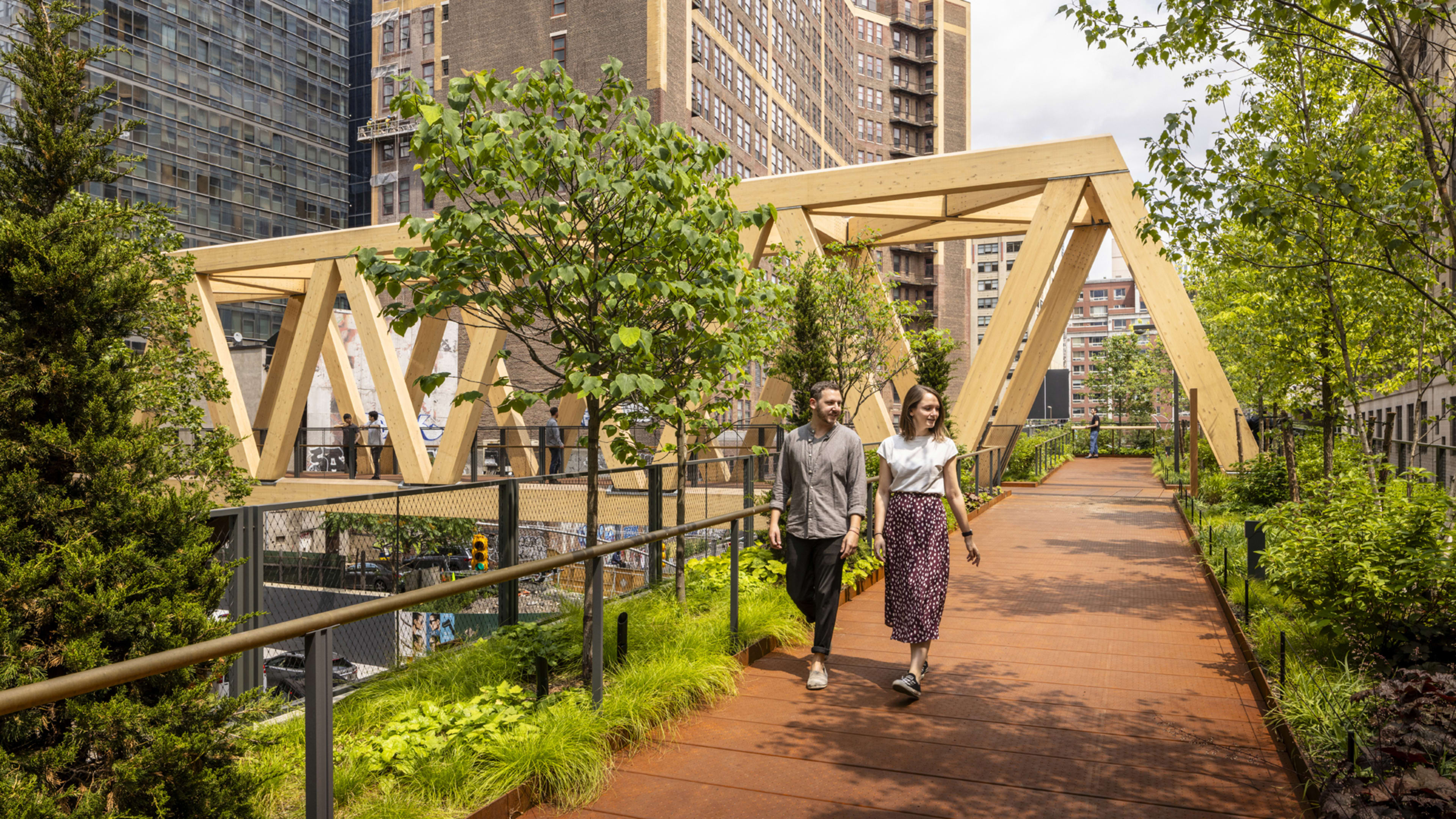One corner of Manhattan just became a lot more walkable.
Today, New York City unveiled an L-shaped bridge connecting the northern end of the High Line (near Hudson Yards) to Moynihan Train Hall, a block and a half east of there. Known as the High Line-Moynihan Connector, the bridge was designed by Skidmore, Owings & Merrill and James Corner Field Operations, who also designed the High Line. It is part of a long-standing vision to create a safer, more enjoyable pedestrian link between one of the city’s most visited public spaces—eight million people per year before COVID—and the city’s busiest transit hub, which see about 700,000 passengers passing through every day.
Two years in the making, the $50 million bridge was funded from New York State’s main development arm, known as the Empire State Development Corporation, as well as Friends of the High Line and Brookfield Properties (which, as it happens, owns Manhattan West, a seven-million-square-foot mixed-use development right off the new Connector.)

Brookfield inevitably stands to benefit from the new link, but luckily, pedestrians do, too. For years, this stretch of land has been a tangle of missing sidewalks, loading docks, and highway ramps abuzz with speeding cars. Previously to get to Moynihan from the High Line, which as a reminder, is elevated 30 feet above ground, pedestrians had to take a stair down to street level, then spend the next few minutes in a hostile version of Total Wipeout, where every obstacle is made of concrete, the biggest of which was the entrance to the Lincoln Tunnel—”a fire breathing dragon type of thing,” as Ken Lewis, managing partner at SOM, put during a recent visit.
As of today, this miserable experience is in the rear view mirror and pedestrians can cross over on a two-prong bridge. Technically, the bridge doesn’t lead straight to Moynihan—pedestrians can walk through the Manhattan West Plaza and enter the train station on the next block—but it gets walkers a lot closer.

The first half of the bridge—a gently sloped, 340-foot-long arm coming out of the High Line Spur, as the final section of the elevated park is called— mimics a woodland path flanked by more than 60 trees, 90 shrubs and more than 5,200 grasses and perennials. Ninety percent of these are native plants that will bloom throughout the year, guaranteeing a “choreography of colors,” says Isabel Castilla, a principal at James Corner Field Operations. Right under the weathered steel floor, an uninterrupted soil bed connects both planted strips, allowing for roots to grow bigger and for large trees to grow on the bridge.
This portion of the bridge ends in a small cantilevering plaza with a bench and a leaning bar for those who may want a moment of respite. Then comes the second half. After a 90-degree turn, pedestrians walk across a 260-foot-long timber bridge made from Alaskan yellow cedar from British Columbia, which Chuck Besjak, a structural engineer at SOM, likened to the “Mercedes of timbers” for its durability. As a nod to the area’s history as a railyard, the bridge was designed to elicit the image of train trusses, complete with 163 beams that cast beautiful shadows on the bridge floor.
To minimize the impact on traffic below, the 128-ton bridge was entirely prefabricated in British Columbia and hoisted by cranes on top of pre-installed Y-shaped steel columns. (Traffic closed for only 24 hours, says Castilla.) As an added bonus, the underside of the bridge looks friendlier to pedestrians now, too. So if anyone wants to stick to street level and forgo taking the bridge, at least they have a safer sidewalk to walk on.
Recognize your brand’s excellence by applying to this year’s Brands That Matter Awards before the early-rate deadline, May 3.
